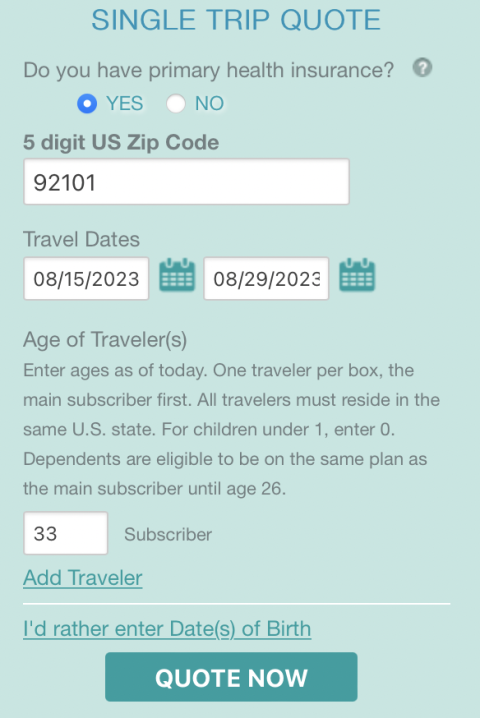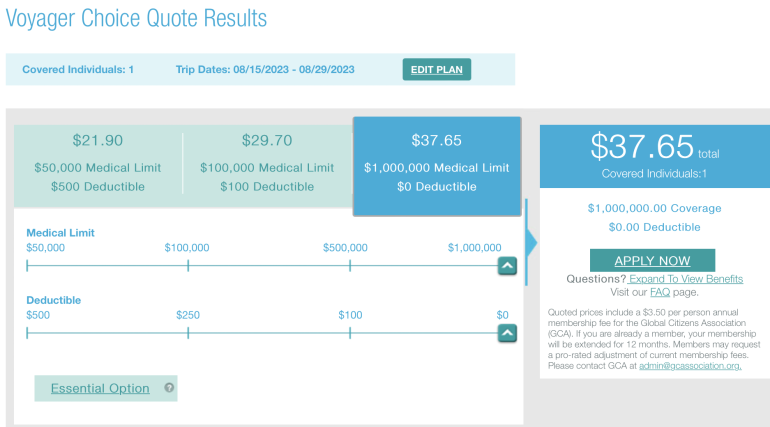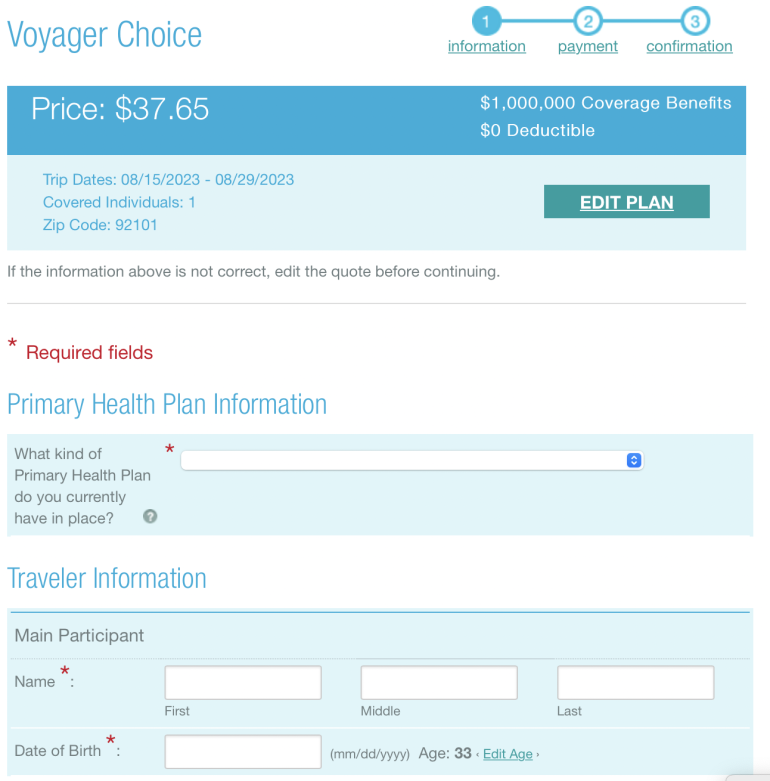GeoBlue Travel Insurance Review: Is it Worth the Cost?

Many or all of the products featured here are from our partners who compensate us. This influences which products we write about and where and how the product appears on a page. However, this does not influence our evaluations. Our opinions are our own. Here is a list of our partners and here's how we make money.
If you’re going on a trip soon, you may be wondering whether to invest in travel insurance. This type of insurance can offer protection in the event that you fall ill, your plans change unexpectedly or you experience unavoidable delays.
GeoBlue is one insurance provider offering plans to travelers, with a number of plans available based on your needs. Here's a review of GeoBlue travel insurance, including the options offered and how to choose your plan.
What does GeoBlue travel insurance offer?
GeoBlue insurance offers two different plans for travelers, though it focuses mainly on medical coverage. These plans are called Voyager Essential and Voyager Choice. The former offers lower coverage options than the latter and is generally cheaper (though as you'll see, not always by a large amount).
The company also provides multitrip, long-term and group options for those who need them.
» Learn more: How much is travel insurance?
GeoBlue travel insurance cost and inclusions
How much does GeoBlue cost? GeoBlue’s travel insurance is mostly medical-based and includes a comprehensive list of inclusions, though it also has coverage for some travel mishaps.
To get an idea of costs, we used a sample trip for a 33-year-old traveler from California with existing insurance heading out in August on a two-week trip.
Note that for this GeoBlue insurance review, we selected the highest coverage amount with no deductible. There are choices that allow you to include a higher deductible and a lower coverage limit, which may lower your plan cost.
Here’s what the two GeoBlue plans cover:
Coverage | Voyager Essential | Voyager Choice |
|---|---|---|
Medical limit | $1,000,000. | $1,000,000. |
Deductible | $0. | $0. |
Surgery, anesthesia, in-hospital doctor visits, diagnostic X-ray and lab | 100%. | 100%. |
Office visits, including X-rays and lab work billed by the attending physician | 100%. | 100%. |
Inpatient medical emergency | 100%. | 100%. |
Ambulatory surgical center | 100%. | 100%. |
Ambulance service (non-medical evacuation) | 100% up to $1,000. | 100% up to $1,000. |
Outpatient prescription drugs (outside the U.S.) | 50% up to $5,000. | 100% up to $5,000. |
Dental care required due to an injury | 100% up to $300. | 100% up to $500. |
Dental care for relief of pain | 100% up to $250. | 100% up to $250. |
Physical and occupational therapy | Up to six visits, up to $100 per visit. | Up to six visits, up to $100 per visit. |
Accidental death and dismemberment | Up to $25,000. | Up to $50,000. |
Repatriation of remains | Up to $25,000. | Up to $25,000. |
Emergency medical transportation | Up to $500,000. | Up to $500,000. |
Emergency family travel arrangements | Up to $2,500 for one round-trip economy class ticket to the hospital. | Up to $2,500 for one round-trip economy class ticket to the hospital. |
Lost baggage and personal effects coverage | $500 per trip, $100 per bag or personal item. | $500 per trip, $100 per bag or personal item. |
Trip interruption | Up to $1,000. | Up to $1,000. |
Quarantine coverage | $25 per day, up to 10 days. | $50 per day, up to 10 days. |
Hazardous activities coverage | Up to $25,000. | Up to $25,000. |
Policy cost | $30.75. | $37.65. |
As you can see, there’s not a big difference when it comes to how much GeoBlue’s plans cost, with just about $7 between the two different offerings.
In terms of benefits, most are the same as well — the biggest difference between the Voyager Essential and Voyager Choice plans comes down to prescription medication coverage and coverage related to accidental death and dismemberment.
The less-expensive Essential plan pays 50% of your prescription costs, while the Choice plan covers the full 100%. As well, the Choice plan doubles accidental death coverage from Essential's $25,000 to $50,000.
Other than that, differences are minimal. You’ll get less coverage for emergency dental care and quarantine expenses, but otherwise, everything else is the same.
» Learn more: How does travel insurance work?
What isn’t covered
Is GeoBlue travel insurance good? Unlike many other travel insurance policies, GeoBlue’s products include coverage for hazardous activities and medical quarantine.
However, while GeoBlue shines when it comes to medical coverage, it falls short in other travel insurance aspects. Many travel insurance plans provide better options in the event that your bags are delayed, your flight is canceled or you miss nonrefundable bookings.
In GeoBlue’s case, the low levels of reimbursement for these types of issues may be problematic. However, bear in mind that many travel credit cards provide complimentary travel insurance that would pair well with a GeoBlue plan.
» Learn more: What to know before buying travel insurance
How to choose a GeoBlue plan online
To purchase a GeoBlue plan online, go to the company’s website.

You’ll see the option to generate a quote and you’ll type in your ZIP code. Then, you'll be taken to a page where you can enter more information, including your dates of travel, whether you have existing insurance and your age.

Once you hit "Quote Now" the results page pops up, which will give you the option to choose your deductible amount and maximum level of coverage. You can also toggle between Choice and Essential plans.

Once you’ve decided on a plan, you’ll need to purchase your policy as a guest, unless you’re a returning customer — in which case, you can sign in to your account.

Then, you’ll be taken through the checkout process, where you’ll need to enter your personal information, what type of insurance you have (if applicable) and make your payment.

After that, your policy will be issued.
» Learn more: 6 common travel insurance myths
Is GeoBlue travel insurance worth it?
While it offers excellent medical care for low prices, GeoBlue’s policies fall short when it comes to other travel coverage. However, if you also have a travel credit card, you may be able to pair the two together for relatively strong travel insurance coverage at a low cost.
How to maximize your rewards
You want a travel credit card that prioritizes what’s important to you. Here are our picks for the best travel credit cards of 2023, including those best for:
Flexibility, point transfers and a large bonus: Chase Sapphire Preferred® Card
No annual fee: Bank of America® Travel Rewards credit card
Flat-rate travel rewards: Capital One Venture Rewards Credit Card
Bonus travel rewards and high-end perks: Chase Sapphire Reserve®
Luxury perks: The Platinum Card® from American Express
Business travelers: Ink Business Preferred® Credit Card


